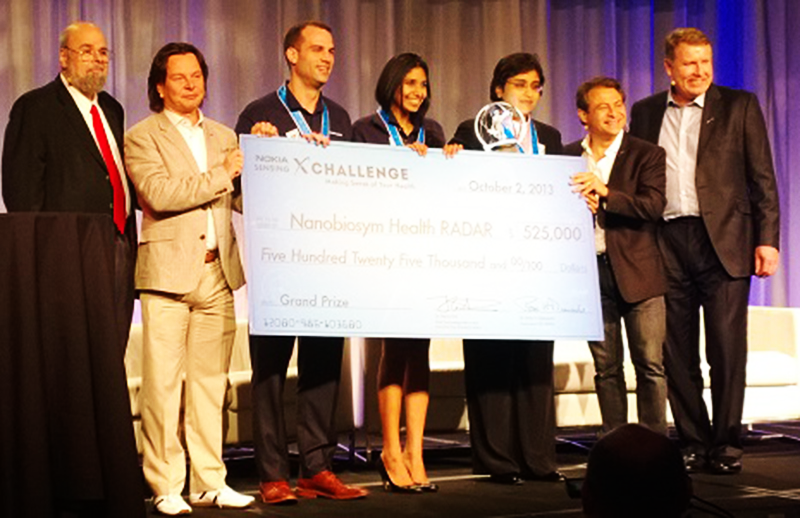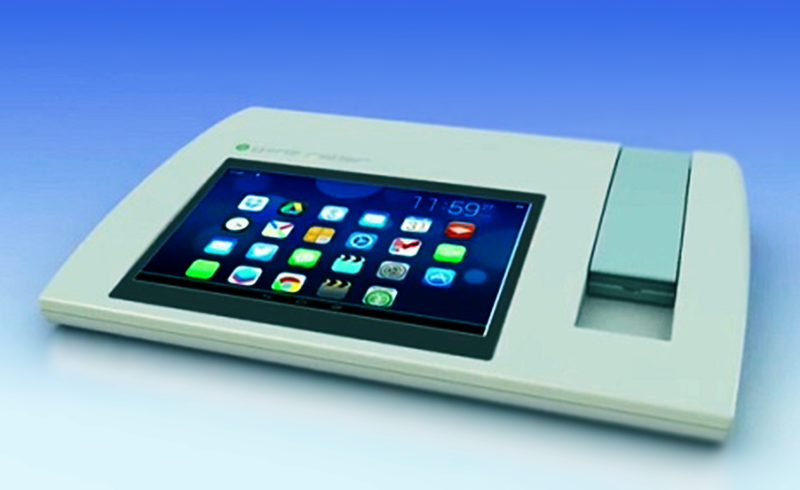Nokia Sensing XCHALLENGE Grand Prix: Nanotechnology against epidemics
Hi, Habr
Back in August, we did a brief tour of our global Nokia Sensing XCHALLENGE competition in the field of modern healthcare. The time has come to tell a little about the project that won the Grand Prix - Gene-RADAR technology from nanotechnology incubator Nanobiosym, which has every chance of making medical diagnostics simple and accessible to everyone.

The project, which won a Grand Prix competition organized by the Nokia and XPRIZE Foundation and $ 525,000 as an investment, is a portable pathogen diagnostic technology. Perhaps you are wondering what is so revolutionary about this?
')
The innovativeness of developing Nanotechnology Nanobiosym incubator from Boston lies in the concept itself: to make a complex, time-consuming and time-consuming medical diagnosis simple and accessible to everyone. The winner of Nokia Sensing XCHALLENGE is committed to ensuring that some of the capabilities of professional medical centers are realized at home. And this, in turn, would allow everyone who cares about their health to prevent the disease even before the first symptoms appear and to seek qualified medical assistance.

At the moment, Gene-RADAR technology has found its embodiment in a compact, outwardly remotely resembling a tablet, mobile device. The device has a removable probe with built-in nanochip, which is used to collect blood samples, saliva or any other biological fluid. After that, it is enough to return the probe back to the device, in order for it to make a qualitative analysis of the sample at the genetic and molecular level and in less than an hour determine the presence of the pathogen. And here there is an important point: the “nanochip - application” link is responsible for determining a certain type of pathogen. In other words, (!) For a specific direction of medical diagnostics, you can create your own applications and install them into the device with the same ease with which Engry Birds is installed on your tablet.

It is worth noting that the ability to quickly identify pathogens, in turn, suggests that Gene-RADAR technology is excellent for detecting and tracking disease outbreaks. Already, Nanobiosym technology makes it possible to identify HIV / AIDS viruses using a special application, and this has been confirmed in a series of clinical trials. Also, the winner of the Nokia Sensing XCHALLENGE Grand Prix has so far developed another application defining E. coli and is currently working on programs that can detect malaria and tuberculosis.
According to Dr. Anita Goël, President and CEO of Nanobiosym, the company does not create a device for individual medicine, and thanks to cloud technology, we strive to ensure that highly qualified medical assistance is as widely used as possible.
“Gene-RADAR technology can be used not only to detect diseases of a particular person. The data downloaded to the “cloud” from a variety of Gene-RADAR devices allows you to determine and control the spread of epidemics in one, separately taken region, ”says Dr. Goel.
According to the project developers, the accuracy of the readings correspond to the “gold standard”, and the estimated cost of the device will be hundreds of times less than the laboratory equipment. Moreover, the full use of Gene-RADAR does not require running water and electricity to identify the pathogen, which makes it particularly useful for implementation in developing countries.
Gene-RADAR in version 1.0 is only the beginning of a long way for both Nanobiosym itself and for global health care in general. In the future, the Boston nanotechnology incubator plans to adapt the technology for mobile devices (smartphones and tablets), and subsequently create a wearable gadget and even diagnostic nanorobots.
Back in August, we did a brief tour of our global Nokia Sensing XCHALLENGE competition in the field of modern healthcare. The time has come to tell a little about the project that won the Grand Prix - Gene-RADAR technology from nanotechnology incubator Nanobiosym, which has every chance of making medical diagnostics simple and accessible to everyone.

The project, which won a Grand Prix competition organized by the Nokia and XPRIZE Foundation and $ 525,000 as an investment, is a portable pathogen diagnostic technology. Perhaps you are wondering what is so revolutionary about this?
')
The innovativeness of developing Nanotechnology Nanobiosym incubator from Boston lies in the concept itself: to make a complex, time-consuming and time-consuming medical diagnosis simple and accessible to everyone. The winner of Nokia Sensing XCHALLENGE is committed to ensuring that some of the capabilities of professional medical centers are realized at home. And this, in turn, would allow everyone who cares about their health to prevent the disease even before the first symptoms appear and to seek qualified medical assistance.

At the moment, Gene-RADAR technology has found its embodiment in a compact, outwardly remotely resembling a tablet, mobile device. The device has a removable probe with built-in nanochip, which is used to collect blood samples, saliva or any other biological fluid. After that, it is enough to return the probe back to the device, in order for it to make a qualitative analysis of the sample at the genetic and molecular level and in less than an hour determine the presence of the pathogen. And here there is an important point: the “nanochip - application” link is responsible for determining a certain type of pathogen. In other words, (!) For a specific direction of medical diagnostics, you can create your own applications and install them into the device with the same ease with which Engry Birds is installed on your tablet.

It is worth noting that the ability to quickly identify pathogens, in turn, suggests that Gene-RADAR technology is excellent for detecting and tracking disease outbreaks. Already, Nanobiosym technology makes it possible to identify HIV / AIDS viruses using a special application, and this has been confirmed in a series of clinical trials. Also, the winner of the Nokia Sensing XCHALLENGE Grand Prix has so far developed another application defining E. coli and is currently working on programs that can detect malaria and tuberculosis.
According to Dr. Anita Goël, President and CEO of Nanobiosym, the company does not create a device for individual medicine, and thanks to cloud technology, we strive to ensure that highly qualified medical assistance is as widely used as possible.
“Gene-RADAR technology can be used not only to detect diseases of a particular person. The data downloaded to the “cloud” from a variety of Gene-RADAR devices allows you to determine and control the spread of epidemics in one, separately taken region, ”says Dr. Goel.
According to the project developers, the accuracy of the readings correspond to the “gold standard”, and the estimated cost of the device will be hundreds of times less than the laboratory equipment. Moreover, the full use of Gene-RADAR does not require running water and electricity to identify the pathogen, which makes it particularly useful for implementation in developing countries.
Gene-RADAR in version 1.0 is only the beginning of a long way for both Nanobiosym itself and for global health care in general. In the future, the Boston nanotechnology incubator plans to adapt the technology for mobile devices (smartphones and tablets), and subsequently create a wearable gadget and even diagnostic nanorobots.
PS: You can learn about all the truly amazing Nanobiosym projects from the Amsterdam speech by Dr. Anita Goelle as part of the TEDx project
Source: https://habr.com/ru/post/206846/
All Articles